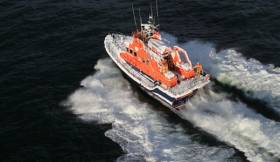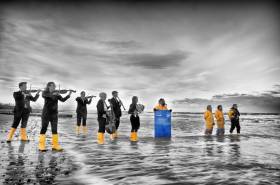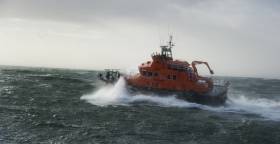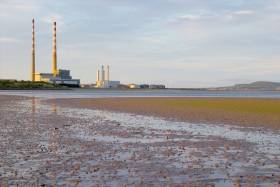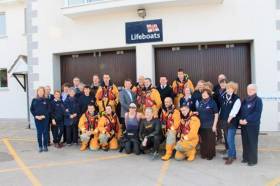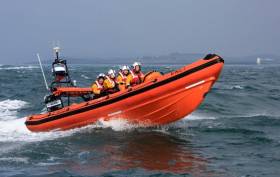Displaying items by tag: RNLI
Sun Shines On St Patrick's Day Donation To Clifden Lifeboat
#RNLI - Bright sunshine and a much appreciated donation was a great start to St Patrick’s Day for the crew of Clifden RNLI.
Longtime supporters and fundraisers Jacqueline Hannon and Nancy Duffy of Claddaghduff, Co Galway presented a cheque for €1,820 to the Clifden volunteer lifeboat crew, the proceeds of a Christmas concert and fundraising event held in Joyce’s Bar in the fishing village of Cleggan on 16 December.
John Brittain, Clifden RNLI Lifeboat Operations Manager said: "We are really delighted to welcome Jacqueline and Nancy to Clifden station once again and would like to thank them most sincerely for the hard work and organisation of this fantastic fundraiser.
"Special thanks also to the people of Cleggan and Claddaghduff who generously supported the event."
After the cheque presentation, the volunteer crew participated in both the Clifden and Roundstone annual St Patrick’s Day parades.
#RNLI - Portrush RNLI had a busy 24 hours earlier this week with two early morning callouts on consecutive days.
The volunteer lifeboat crew was alerted at 4.45am on Monday (14 March) to reports of a fishing vessel that had lost power two miles off the coast of Ballycastle.
However, as the all-weather lifeboat approached Ballycastle the crew was stood down as another vessel had responded and assisted the vessel to get underway.
The crew was requested to launch once again went at 12.30am yesterday morning (Tuesday 15 March) to reports of a 23m fishing vessel 12 miles northwest of Portrush that had got nets caught around its propeller.
The weather was cold but calm and the Portrush lifeboat crew were joined by their lifeboat colleagues from Lough Swilly RNLI and their new Shannon class lifeboat, The Derek Bullivant.
The Portrush crew attached a towline to the fishing vessel and towed her into Greencastle Harbour under the guidance of Lough Swilly RNLI
The Portrush crew had last seen the Shannon when she and her crew made Portrush their last call when returning from Poole to Buncrana in April last year.
Speaking following the callout, Portrush RNLI lifeboat operations manager Robin Cardwell said: "This was a tow for which both crews are trained and executed perfectly.
"The Portrush crew towed the vessel into Greencastle and aworked well with our flank station Lough Swilly who helped us into harbour."
Fun & Fitness At Lough Ree RNLI Charity Cycle
#RNLI - Lough Ree RNLI’s third annual Lap Of Lough Ree charity cycle took place on Sunday 6 March, with 88 cyclists setting off in cold, dry weather at 10am.
The cycle started and finished at The Bounty, Buccaneers Rugby Club in Athlone and travelled north through Ballymahon, crossing the Shannon at Lanesborough, where refreshments were available courtesy of the Radisson Blu Hotel.
Cyclists then completed the 85km lap of Lough Ree in somewhat wetter conditions, travelling south on the Roscommon side, via Kilteevan, crossing the Shannon again at Athlone Bridge and returning to The Bounty for the finish.
Hot drinks were available at The Bounty for the returning cyclists, who reported that the going was a little slow for the first section but picked up pace nicely from Lanesborough.
Many of the attending cyclists are members of cycling clubs, and enjoy this event as a warm-up for the upcoming competitive cycling season.
Lough Ree RNLI treasurer Vincent Rafter said: "The cycle was a great success again this year and is becoming a firm fixture on the cycling calendar, as well as drawing casual cyclists from the area. There is a nice camaraderie among participants of all ability, and good fun was had along the way."
In other news, Lough Ree RNLI is currently seeking volunteers to join the lifeboat crew and shore crew.
This is a great opportunity to make a difference in your community, meet new people and use your skills to support the RNLI.
Boating experience and knowledge of Lough Ree are preferred but not essential. All training and kit is provided.
If you are interested and have the time to commit to this role, please contact Lough Ree RNLI lifeboat operations manager Damien Delaney at 087 2437092 for further information. The closing date for expression of interest is Monday 21 March.
Kilkeel Lifeboat Aids Fishing Vessel Rapidly Taking On Water
#RNLI - Kilkeel RNLI's volunteer lifeboat crew launched at 9.20am yesterday morning (Monday 14 March) to go the aid of a fishing vessel rapidly taking in water about 25 miles southeast of Kilkeel, Co Down.
The vessel was in a heavy swell when water was seen in the fish room. The boat’s pump was unable to cope with the water entering and at one stage the fish room was three-quarters full of water. It had begun to affect the stability of the boat when the alarm was raised and help was dispatched.
When Kilkeel RNLI arrived on scene, the lifeboat was carefully manoeuvred by its volunteer crew alongside the vessel in an increasingly heavy swell, and two of the lifeboat crew went aboard the fishing vessel with a salvage pump. Newcastle RNLI’s all-weather lifeboat was also on scene to render assistance.
The Kilkeel lifeboat then transferred a further pump from the Newcastle lifeboat, and with all the pumps working the boat was kept afloat. The two lifeboats then escorted the fishing boat under her own steam safely into Kilkeel Harbour, arriving at about 12.45pm.
John Fisher, Kilkeel RNLI lifeboat operations manager, said: "If the incident had happened further out to sea then the operation would have been more difficult, but with the Kilkeel and Newcastle lifeboats co-operating well together, the fishing boat and its crew were brought safely ashore.
Kilkeel RNLI's volunteer lifeboat crew on this callout were Raymond Newell, Alan Henning, Andrew McConnell and Wayne Marshall.
An Irish amateur orchestra is set to realise their dream of performing on the stage of the National Concert Hall in Dublin when they play a specially composed piece of music commemorating the Helen Blake maritime tragedy where nine lifeboat crew lost their lives off the Irish coast. The Wexford Sinfonia will play the ‘Heroes of the Helen Blake’ Suite on the main stage this May to raise funds for the RNLI, the charity that saves lives at sea.
Volunteer lifeboat crewmember and orchestra Chairman Keith Miller approached Wexford composer Liam Bates a few years ago to commemorate the incredible events during three days in 1914 where nine lifeboat volunteers lost their lives and ten sailors were saved when the Mexico struck rocks. After working with the Sinfonia's musicians and researching the history of the shipwreck and tragic rescue, Liam wrote a five-part suite: ‘Heroes of The Helen Blake’. It was premiered in front of a sell-out crowd at the Wexford County Hall in 2014 and the dream of the orchestra has been to bring it to the National Concert Hall in Dublin. Now two years later it is finally happening and the musicians hope it will be a sell-out.
The orchestra was founded in 1993 by a group of music teachers and is the only Irish amateur symphony orchestra based in a county town. The musicians range in age from 14 to 80 and come from all walks of life. They share a common interest of performing music together to the highest possible standard.
To promote the upcoming concert the orchestra wanted to do something different and turned to their clarinettist Alan Mahon to take a photograph with a difference that would reflect all the emotions behind the piece of music. Pictured are members of the Wexford Sinfonia with their instruments alongside RNLI volunteer lifeboat crew standing looking out to sea. All profits from the concert will go to the work of the RNLI in Ireland, saving lives at sea.
Commenting on the event RNLI crewmember and orchestra Chairman Keith Miller said, ‘We have waited two long years to bring this incredible piece of music to a larger audience. The National Concert Hall is the perfect venue for it and we are very excited to finally play it here. It was also very appropriate that we do it on Mayday which is the RNLI’s annual fundraising appeal day. ‘
‘Nine lifeboat crew lost their lives that day but ten shipwrecked sailors were brought home safe. As a lifeboat man and a musician I feel we should acknowledge these events in our history. There are many descendants of the lifeboat crew from that time living and volunteering on RNLI lifeboats today who feel tremendous pride in the achievements of their ancestors. We would love to share this story with a wider audience and we hope that people will join us for what promises to be a great afternoon of music and the maritime.’
Heroes of the Helen Blake will be performed in the main auditorium of the National Concert Hall on Sunday 1 May at 3pm. Tickets are priced at €20 (students €15) with funds raised going to the RNLI. Tickets can be purchased at the National Concert Hall Box Office or by booking online at www.nch.ie
Two fishermen have been brought to safety this afternoon by the RNLI after they got into difficulty off the Wexford coast.
Wexford RNLI was requested to launch their inshore lifeboat at 12.08pm following a report that a fishing vessel with two people on board was experiencing mechanical difficulty a mile and a half south east of Blackwater Head.
The lifeboat helmed by Frank O’Brien launched and made its way to the scene. Wexford RNLI then requested the assistance of Rosslare Harbour RNLI due to the location of the fishing vessel some 12 miles north of Rosslare Harbour. It was the fourth call out in a week for the volunteer lifeboat crew from Rosslare.
The all-weather lifeboat under Coxswain Eamonn O’Rourke and with eight volunteer crew members on board launched at 12.29pm and made its way to the scene.
Weather conditions at the time were described as overcast but good. The men had been razor fishing when their boat got caught in lobster pots.
Once on scene, the lifeboat crew observed that no one was in immediate danger and began to work with the fishermen to establish a towline.
The vessel was then taken under tow and brought to the bar of Wexford escorted all the time by Wexford RNLI’s inshore lifeboat. Once there, Wexford RNLI took over and brought the vessel to shore at 4pm with the assistance of another fishing vessel which was in the area at the time. Having only finished a routine exercise when they were requested to launch at midday, this meant the volunteers from Wexford had spent some six hours at sea.
Meanwhile, yesterday (Saturday 12 March) Rosslare Harbour RNLI’s all-weather lifeboat under Coxswain Keith Miller launched in thick fog at 7am after a fishing boat with three people on board was reported to have lost its rudder just off Rosslare. The lifeboat once on scene took the boat under tow and brought it to Blackrock where it was met by Kilmore Quay RNLI’s all-weather lifeboat which towed it into Kilmore Quay.
Meanwhile, at 6.30am on Thursday, the lifeboat launched under Coxswain Eamonn O’Rourke to go the assistance of a fishing boat which had broke from her moorings overnight and blew ashore due to a change in the weather conditions. On this occasion the lifeboat crew established a tow before the vessel was brought alongside the fishermen’s wall in the harbour.
Speaking following today’s call out, David Maloney, Rosslare Harbour RNLI Lifeboat Operations Manager said: ‘The fishermen did the right thing this afternoon and raised the alarm when they began to experience some difficulty. Our volunteers both from Rosslare Harbour and Wexford responded rapidly and worked well together to bring the fishermen safely to shore. It has been a busy week for our volunteers but they are always ready and delighted to help anyone in need at sea.’
Two walkers were rescued by the RNLI inshore lifeboat from Dun Laoghaire shortly after midday today when the rising tide surrounded them half a mile from shore off Sandymount.
The pair raised the alarm by mobile phone to the Irish Coast Guard Dublin rescue co-ordination centre (MRCC Dublin) giving details of their difficulty. They then attempted to walk towards shore but with the water-level waist deep and rising they returned to the sandbank to await rescue. Their phone became water-logged in the fast-rising tide and with two hours to high-water, the sea-level was rising faster than walking in water-logged clothing would allow.
MRCC Dublin contacted the RNLI Inshore lifeboat (ILB) from Dun Laoghaire that was on exercise with four volunteer crew on board and requested that they proceed immediately to the scene. The Irish Coast Guard helicopter at Dublin Airport was also tasked and both arrived on scene at 12.15pm
The ILB crew walked the remaining 50-metres with life-jackets for the two walkers who were then brought by lifeboat to Dun Laoghaire. Neither was harmed though First Aid for a minor injury was given to one of the walkers. The Dun Laoghaire Coast Guard Unit attended at the RNLI station and brought the casualties back to their car at Sandymount by road.
“Walking on our local beaches is very popular but care is needed in respect of the state of tide that is constantly changing,” commented Robert Fowler, Deputy Launching Authority with Dun Laoghaire RNLI. “From low-tide to high, water-level can become several metres deep in the course of a long-walk at the waters’ edge.”
A recent risk-analysis by the RNLI for the Dun Laoghaire station indicates that walking poses one of the most significant hazards in the area with today’s incident the third of its kind to date this year.
The ILB is one of two lifeboats stationed by the RNLI at Dun Laoghaire and is ideal for operating in shallow water and close to rocks. The volunteer crew typically launch within six minutes of being paged but were already at sea today on one of two weekly routine training exercises.
#OpenWaterSwim - The first ever Dunmore East RNLI Open Water Swim was launched with great fanfare yesterday (Thursday 10 March) by well-known hotelier John Brennan.
A very keen sailor who's hosted boating events at his Dromquinna Manor in Kenmore, Brennan visited the lifeboat station to officially launch the swim and to give his support to the work of the RNLI.
Brennan also runs the famous Park Hotel along with his brother Francis, and the two presented the popular TV show At Your Service together for a number of years.
He has huge interest in all things maritime, and his son Adam has recently graduated as a Super Yacht Master on the Isle of Wight. All of this made him the perfect choice for the launch.
The swim will take place on Sunday 29 May, with the first swim starting at noon. The three swims will be over distances of 500m, 750m and 1500m.
As the demand for and interest in different sporting events increases, the fundraising branch of Dunmore East were keen to host a major event that would see people take part in a rewarding and challenging open water swim.
Speaking at the launch, Dunmore East RNLI crew member Neville Murphy said: "We had the idea for this swim for quite a while before we took the plunge and went for it.
"We live in one of the most beautiful parts of the country with a stunning coastline and it is the perfect location for this type of event. We hope that for this our first year, we generate lots of interest and entries, which in turn will help us raise funds for the RNLI and their lifesaving work."
Murphy added: "We are very grateful to John Brennan who made the long journey from his home in Kerry to launch our event. Many people know him for his hospitality work, but he is also a very keen sailor and he knows the importance of people being able to swim when you live on our coastline."
Throwing his support behind the event, Brennan said: "As I know personally, it can be quite challenging to get a new venture off the ground. I hope people will get behind it and raise funds for the RNLI, which is a great charity and one close to my heart as a sailor."
Following the launch, Brennan kindly donated a voucher for two nights B&B and dinner in his luxurious five-star Park Hotel in Kenmare.
The event committee has decided to hold a random draw on the day which will include all event participants and the selected winner will receive the voucher as a prize. All prizegiving will take place in Waterford Harbour Sailing Club after the completion of all three swims.
For more information about the Dunmore East RNLI Open Water Swim and to register online go to www.athleticstiming.com. Entry costs €25.
#RNLI - The volunteer lifeboat crew at Portaferry RNLI launched yesterday afternoon (Tuesday 8 March) to the aid of two kayakers stranded on an island in Strangford Lough.
The two men were on a camping trip to Boretree Island, just off the coast at Mount Stewart, and had paddled out to set up their tent.
When they returned to where they had landed their kayak, they found that it had drifted off in the tide.
Waving a flag to attract attention, the two men were spotted by walkers on the mainland shore who contacted the coastguard, who subsequently requested Portaferry RNLI to launch to rescue the campers.
Weather conditions at the time were good, slightly cloudy with a slight Force 3 wind. Visibility was good and sea conditions were also fairly calm.
The volunteer crew of the Portaferry lifeboat, an inshore Atlantic 85, launched at 12.40pm and were quickly on scene, where they transferred the two men into the lifeboat. They were then taken safely to shore at Newtownards Sailing Club.
Brian Bailie, lifeboat operations manager for Portaferry RNLI, said: "We are delighted to once again have been able to provide assistance to members of the public who found themselves in trouble at sea.
"With its fast flowing currents and tides, Strangford Lough can at times catch out even the most experienced. The lough has for a long time and will for the foreseeable future be a real draw for water enthusiasts and we at Portaferry RNLI are always ready to provide assistance when required."
Donaghadee Lifeboat Volunteers Are Ready For Action
#RNLI - On Sunday 6 March 2016, Donaghadee RNLI coxswain Philip McNamara and the volunteer lifeboat crew mustered for the latest in a series of vital fortnightly sea training exercises to ensure they are prepared for the challenges of the year ahead.
The Trent Class lifeboat Saxon was also hauled up a slipway in Carrickfergus last week to have its hull power-washed and a fresh coat of antifouling paint applied. The task is undertaken every six months to ensure the £2 million vessel is always at peak performance and can reach the scene of an emergency at 25 knots.
Last year Donaghadee’s RNLI volunteers responded to 23 calls for help starting in January when they battled "atrocious" seas to bring an injured workman from the Copeland Islands where he has working on the lighthouse.
The lifeboat crew rescued stranded kayakers and their dogs. They came to the rescue of a member of the crew on a cross channel ferry who had taken seriously ill during a night crossing.
“It has been a relatively quiet winter for us but the number of rescue requests usually picks up around Easter and reaches a peak in summer," said McNamara.
"The crew is ready and the lifeboat is ready too. Every time we put to sea volunteers risk their lives to save others but we are trained and experienced, to deal with emergencies and are part of a dedicated team which includes the Coastguard, Police Service of Northern Ireland, Northern Ireland Fire and Rescue Service and Air Sea Rescue.”
The Donaghadee crew is at full strength, but lifeboat operations manager Peter Irwin says there is still room for more.
“We would like two more trainees to join us and I would be happy to hear from suitable people in the town who feel they can give their time to the charity that saves lives at sea.”





























